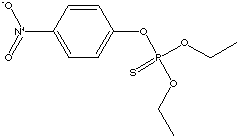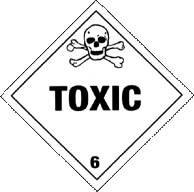Parathion
- Diethyl parathion
- Ethyl parathion
- O,O-diethyl-o-(4-Nitrophenyl) phosphorothioate
- Parathion-Ethyl
- Phosphorothioic acid O,O-diethyl o-(4-Nitrophenyl) ester
- Thiophos

Parathion | |
| |
| Formula | C10H14NO5PS |
| Structure |  |
| Description | Light-yellow liquid, it turn solid at 6 C, a deadly poison by all routes. |
| Uses | Parathion controls a variety of insects such as aphids, mites, beetles, lepidoptera, leaf hoppers, leafminers, and other pests found on fruits, cotton, vegetables, and forage crops. It also controls several soil insects such as wireworms, rootworms, and symphilids. |
| Registry Numbers and Inventories. | |
| CAS | 56-38-2 |
| EC (EINECS/ELINCS) | 200-271-7 |
| EC Index Number | 015-034-00-1 |
| EC Class | Very toxic; Dangerous for the Environment |
| RTECS | TF4550000 |
| RTECS class | Agricultural Chemical and Pesticide; Tumorigen; Mutagen; Reproductive Effector; Human Data |
| UN (DOT) | 2783 |
| Merck | 12,7167 |
| Beilstein/Gmelin | 2059093 |
| Beilstein Reference | 4-06-00-01337 |
| RCRA | P089 |
| EPA OPP | 57503 |
| Swiss Giftliste 1 | G-2073 |
| Austrailia AICS | Listed |
| Properties. | |
| Formula | C10H14NO5PS |
| Formula mass | 291.26 |
| Melting point, °C | 6 |
| Boiling point, °C | 375 |
| Vapor pressure, mmHg | 3E-5 (25 C) |
| Vapor density (air=1) | 1.262 |
| Density | 1.2704 g/cm3 (20 C) |
| Solubility in water | 10 mg/L |
| Viscosity | 15.30 cp (25 C) |
| Surface tension | 39.2 g/s2 (25 C) |
| Refractive index | 1.53301 (20 C) |
| Partition coefficient, pKow | 3.83 |
| Heat of vaporization | 58.5 kJ/mol |
| Heat of combustion | -6190 kJ/mol |
| Hazards and Protection. | |
| Storage | Keep in well ventilated area. Protect against physical damage. Store at in areas where any spillage would not endanger workers or contaminate other materials. |
| WHMIS | D1A D2A |
| Handling | All chemicals should be considered hazardous. Avoid direct physical contact. Use appropriate, approved safety equipment. Untrained individuals should not handle this chemical or its container. Handling should occur in a chemical fume hood. |
| Protection | Wear appropriate chemical protective clothing. |
| Respirators | Wear positive pressure self-contained breathing apparatus. |
| Small spills/leaks | Do not touch damaged containers or spilled material unless wearing appropriate protective clothing. Stop leak if you can do it without risk. Prevent entry into waterways, sewers, basements or confined areas. Cover with plastic sheet to prevent spreading. Absorb or cover with dry earth, sand or other non-combustible material and transfer to containers. DO NOT GET WATER INSIDE CONTAINERS. |
| Stability | Stable. Decomposes at elevated temperature, and in containers may develop sufficient pressure to rupture. |
| Incompatibilities | Avoid contact with strong oxidizers, alkaline materials. Violent reaction with endrin. |
| Decomposition | Toxic gases and vapors (such as carbon monoxide, oxides of nitrogen, phosphorus and sulfur) may be released when parathion. Undergoes decomposition. |
| Fire. | ||||
| Flash Point,°C | 174 | |||
| Fire fighting | SMALL FIRES: Dry chemical, carbon dioxide or water spray. LARGE FIRES: Water spray, fog or regular foam. Move containers from fire area if you can do it without risk. Dike fire control water for later disposal; do not scatter the material. Use water spray or fog; do not use straight streams. FIRE INVOLVING TANKS OR CAR/TRAILER LOADS: Fight fire from maximum distance or use unmanned hose holders or monitor nozzles. Do not get water inside containers. Cool containers with flooding quantities of water until well after fire is out. Withdraw immediately in case of rising sound from venting safety devices or discoloration of tank. ALWAYS stay away from tanks engulfed in fire. For massive fire, use unmanned hose holders or monitor nozzles; if this is impossible, withdraw from area and let fire burn. | |||
| Fire potential | May burn but does not ignite readily. | |||
| Hazards | Containers may explode when heated. Runoff may pollute waterways. Substance may be transported in a molten form. | |||
| Combustion products | Fire may produce irritating, corrosive and/or toxic gases. | |||
| NFPA | Health | 4 | ||
| Flammability | 1 | |||
| Reactivity | 2 | |||
| Health. | |
| Exposure limit(s) | TLV: ppm; 0.1 mg/m3 (skin) (ACGIH 1992-1993). PDK: 0.05 mg/m3 P (USSR 1987). OSHA PEL: TWA 0.1 mg/m3 skin NIOSH REL: TWA 0.05 mg/m3 skin NIOSH IDLH: 10 mg/m3 |
| Exposure effects | Vital sign changes can include slow or rapid heart rate, abnormally low blood pressure or elevated blood pressure, rapid breathing, respiratory paralysis or fever. Headache, dizziness, muscle spasms, profound weakness, paralysis, confusion, slurred speech and loss of reflexes are common symptoms of dichlorvos overexposure. Altered level of consciousness, seizures and coma may occur. Seizures may be more common in children. |
| Ingestion | Vomiting, diarrhea, fecal incontinence, pancreatitis and abdominal pain may occur, especially from percutaneous and inhalation exposures. |
| Inhalation | Dyspnea, rales, bronchorrhea, or tachypnea may be noted. Pulmonary edema may occur in severe cases. |
| Skin | Sweating is a consistent but not universal sign. |
| Eyes | Constriction of the pupil, tearing, blurred vision and salivation are common. Prolonged dialation of the pupils may occur in severe poisonings. |
First aid |
|
| Ingestion | Seek medical assistance. |
| Inhalation | Move victim to fresh air. Apply artificial respiration if victim is not breathing. Do not use mouth-to-mouth method if victim ingested or inhaled the substance; induce artificial respiration with the aid of a pocket mask equipped with a one-way valve or other proper respiratory medical device. Administer oxygen if breathing is difficult. |
| Skin | Remove and isolate contaminated clothing and shoes. Immediately flush with running water for at least 20 minutes. For minor skin contact, avoid spreading material on unaffected skin. |
| Eyes | Immediately flush with running water for at least 20 minutes. |
| Transport. | ||
| UN number | 2783 |  |
| Response guide | 152 | |
| Hazard class | 6.1 | |
| Packing Group | I; II; III | |
| USCG CHRIS Code | PTO | |
| Std. Transport # | 4921470 | |